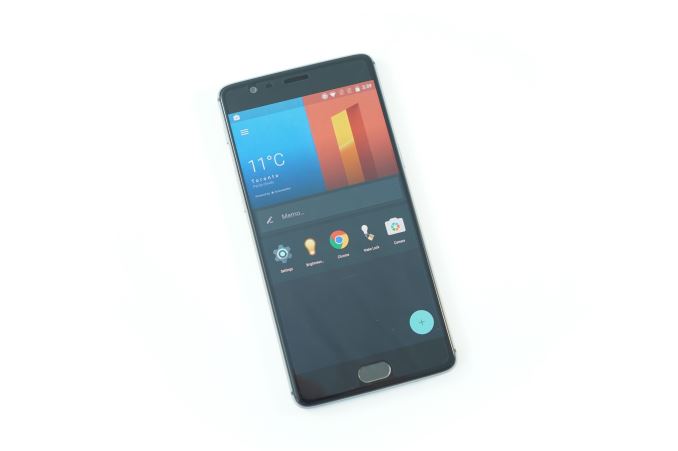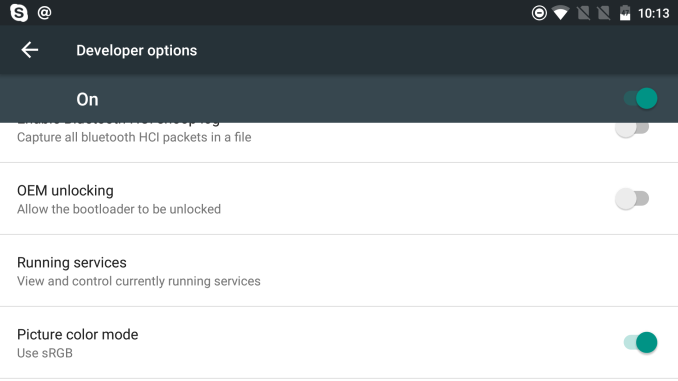Revisiting The OnePlus 3: sRGB, Memory Management, & More
by Brandon Chester on June 30, 2016 3:00 PM EST- Posted in
- Smartphones
- OnePlus
- OnePlus 3

Last week I published my review of the OnePlus 3. I reviewed the OnePlus 2 for AnandTech, and given that the OnePlus 2 had many problems it seemed appropriate that I should examine the improvements that OnePlus made with their latest smartphone. As I used the phone, I was glad to see that OnePlus had clearly taken feedback from the reviews of the OnePlus 2 to heart and spent the year since then working on creating a truly great phone. From the chassis, to the camera, to the SoC, the OnePlus 3 really delivered a level of quality comparable to phones that cost significantly more.
There was one exception to this trend, which was the OnePlus 3's display. The OnePlus One shipped with a 5.5" 1080p IPS display, and it clearly aimed to accurately render content targeting the sRGB color space, which applies to essentially all content that you'll see on a smartphone. With the OnePlus 2 things weren't so great. OnePlus still used a 5.5" 1080p IPS display, but there was essentially no effort put into calibrating the display. As for the OnePlus 3, it marked a shift from IPS LCD displays to AMOLED displays in OnePlus's flagship smartphones, and this was to be expected based on the launch of the OnePlus X which sports a 5" 1080p AMOLED display.
The move to AMOLED doesn't come with any inherent issues, but there are things that a manufacturer needs to keep in mind. Without any sort of brightness boost mode the display can be more difficult to use outdoors than competing LCDs, due to AMOLED displays typically capping at 300-400 nits when setting brightness manually. Sharpness is also another factor to consider. The use of the PenTile subpixel arrangement reduces effective resolution, especially when rendering areas of solid color. It also has a negative impact on the rendition of text and other glyphs, as you're not dealing with subpixels aligned in a perfect grid of vertical and horizontal lines. This is why I've advocated for remaining at 1080p when using standard RGB displays but moving to 1440p for PenTile displays. In fact, the red/blue resolution on a 1440p PenTile display is still slightly lower than that of a 1080p RGB display, but that's another topic.
The last thing vendors need to keep in mind about AMOLED displays is that, while they can offer a much greater color gamut than your typical WLED-backlit LCD, without color management this will cause distortions in all content you view on the display. For this reason it's important to offer an sRGB color mode which constrains the display so that it matches the color standard used by essentially all content. Unfortunately, the OnePlus 3 omitted such a feature, which is why it ended up performing so poorly in my display testing.
The display section of my review spawned a great deal of debate, and I'll get into that more on the next page. To sum things up, OnePlus was quickly able to ship a preliminary update to review units which added an sRGB mode in the phone's developer settings. Right now this setting resets upon a reboot, but OnePlus says that it will keep its state between reboots when the stable firmware goes out to all devices. With OnePlus making an effort to correct what I felt was the biggest issue with the OnePlus 3, I thought it only made sense to revisit the display and run it through the tests again to see just what sort of changes have been made, and whether they improve the OnePlus 3's standing among smartphones.
A quick word on memory management:
Before discussing the changes that OnePlus has made to the display, I did want to comment on one of the other controversial aspects about the OnePlus 3. I only mentioned this once in my review, but the OnePlus 3's memory management on its original firmware is quite aggressive about evicting apps from memory, which led many people to wonder why OnePlus had included 6GB of RAM if you couldn't use it. With the beta update that they've sent to review units one of the patch notes states that this behavior has been tweaked somewhat. While I'm not able to do any in-depth comparisons due to the fact that I'm now stuck on this firmware, I did want to mention that app eviction seems to be less aggressive. In my admittedly not very scientific testing I was able to have Chrome with three tabs loaded, Twitter, Hangouts, Dropbox, Google Drive, Gmail, Skype, the Files app, and Google Photos all resident in memory at the same time, and none had to recreate their activities upon me returning to them. Pushing any further would honestly be going far outside the set of apps that I use on a daily basis and can keep track of in my mind, and so at least in my view I don't think app eviction is something to worry about on the OnePlus 3 as of this new firmware.
With that out of the way, lets take a look at the new sRGB mode that has been added to the OnePlus 3.











81 Comments
View All Comments
MrCommunistGen - Thursday, June 30, 2016 - link
Oh, I didn't mean to only post that. I also wanted to thank you for your diligence in doing the additional testing and for your well written objective analysis as well as your personal commentary on the topic of color accuracy.I think that this is a topic that more people would care about if they knew about it, and articles like this are a step in that direction.
Brandon Chester - Thursday, June 30, 2016 - link
I do plan to do this. I'm just at work right now, will be updating both the display and conclusion sections of the original review around 5PM EST.MrCommunistGen - Thursday, June 30, 2016 - link
Awesome!Stochastic - Thursday, June 30, 2016 - link
OnePlus One owner here. My one big gripe with the OPO is that, at least on T-Mobile, reception is pretty terrible. In your experience does the OnePlus 3 have any issues receiving LTE? In your review you wrote that "I'm still unable to achieve a strong enough signal over LTE to get results that are comparable to those run by Josh and Matt" which concerned me.Brandon Chester - Thursday, June 30, 2016 - link
That's not due to the phone. My apartment just has terrible cellular reception on both our major networks on all my devices. I'm only pulling -97dBm, so I've decided to stop directly comparing my results, at least until I move at the start of August where I'll have to investigate the signal again.Lolimaster - Thursday, June 30, 2016 - link
Meanwhile I currently have my firefox with 200tabs and just 4GB of memory on my Athlon II X4 620, feels snappy.MrCommunistGen - Thursday, June 30, 2016 - link
There are likely other factors involved as well. First one off the cuff is that modern desktop OSes like Windows manage memory differently than Android. I guess there's a chance things have changed, but AFAIK Android does not use a pagefile to help alleviate memory pressure.Also, on mobile devices, the VRAM is still allocated out of a chunk of RAM. If your desktop has a dGPU, that'd be extra memory available on desktop vs mobile.
Unfortunately I'm not terribly well versed in this topic and can't really provide much specific insight.
thek - Thursday, June 30, 2016 - link
Hi, Look!It's a reviewer that clearly forgot what it was to be an average day to day consumer and only thinking like a reviewer - with only numbers in his mind .. (kind of like politicians these days..huh), and bashed an apparently really decent phone(..or a superb! if you take into account the cost of it which is half the cost of a new galaxy or Iphone) for nothing really. just because it wasn't amazing.
I swear, I thought about not buying this phone just because of your earlier review and what you said about the display, but thank god there are other decent reviewers out there. Once no one(literally no one) even mentioned the display I knew it was probably because you were relying too much on the numbers instead of actually looking at the screen. Then I went into youtube to watch vid reviews (and display reviews between the OP3 and other flagships) and clearly the OP3 was not the worse, as you said...and surprisingly enough, just from eye-to-eye, it was sometimes the best.
thek - Thursday, June 30, 2016 - link
just adding, I started liking AnandTech less since your review.MrCommunistGen - Thursday, June 30, 2016 - link
"Beauty is in the eye of the beholder" is an age old adage for a reason. As I think Brandon mentioned in the review, much of the consumer base actually prefers oversaturated colors. This is part of what won early AMOLED panels their consumer appeal.The point of an thorough and critical review is not to say the same thing as every other site. It is to push the boundaries of what is examined. To perhaps find things that a device does particularly well, or in this case something a device might not do well.
Personally, I'd like to know there is a *potential* issue with a device and be able to make an educated decision based on that, rather than no one looking deep enough, me buying the device, and seeing something clearly different on the display than I was expecting.
The point of color accuracy isn't necessarily to provide picture that looks the best, but rather to display the colors that were actually called for.
My rather poor example is: Say you are helping a friend buy a used car. You take a picture of a car whose paint looks faded and send it to your friend. For the case of this example, lets say that the picture taken was perfect. The lighting, exposure, and color represented in the image are exactly as it looks in real life. When viewed on a device with an oversaturated display, that car might look better than it does in real life. It might not look faded.
If the conversation you're having is: "Hey <your friend's name>, I think the car is in good shape but the paint looks faded" <insert picture>
If your friend's phone has an oversaturated display, he might say: "Naw, it looks fine to me" when in fact the paint looks terrible. When he shows up to buy the car he's probably going to be disappointed.
I understand this is a very narrow example, but I hope it illustrates the difference between making an image look "good" vs accurate.